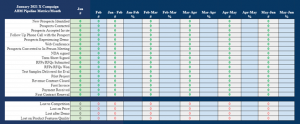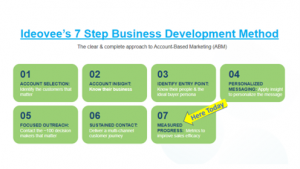
“While B2B CMOs say measuring ROI is their top priority, less than 20% report having the capability.” ― Forbes
“Without data, you’re just another person with an opinion.” ― W. Edwards Deming
“Since ABM is a fundamentally different approach, it requires different metrics – metrics that provide an account-centric lens to your measurement.” ― Brandon Redlinger, Director of Growth at Engagio
~~~~~~~~~~~~~~~~~~~~~~~~~~~~~~~~~~~~~~~~~~~~~~~~~~~~~~~~~~~~~~~~~~~~
What is ABM supposed to measure?
Account-based marketing is a strategic process. Measurement is one of the 7 steps. ABM by itself doesn’t measure but it guides each team following ABM to create the measurements that matter to the business across all functional stakeholders. Each team member from sales, marketing, finance, business development, and operations must be part of the discussion and formation of the ABM measurements. These common goals unify our revenue team across functions. No one team or team member succeeds unless the business overall succeeds in driving revenue results. Revenue becomes unified team support and not a collection of disjointed individual efforts.
We’ve had an ongoing discussion about the “right” measurements for ABM campaigns. “It differs for each client and each campaign.” is a truism we hear but we also feel that response doesn’t dig deep enough. That jump ball statement punts the decision to a later time. We’ve been grappling with the questions from clients about how to measure the performance of ABM campaigns.
We have identified a few fundamental elements to evaluate for measurement. They follow chronologically as the revenue effort begins:
- # of prospect companies (ABM 1: Account Selection)
- # of people identified at the prospect companies (ABM 2: People Insight)
- campaign expense budget and revenue forecast, by milestones and date
- # of people contacts in outreach (ABM 5: Outreach)
- % of contacts who affirmatively accept the connection (E.G. Linkedin, email response, meeting at a trade show, etc.), the absolute number and expressed as a % (connections/total people)
- # of customer journey milestones (ABM 6: Customer Journey) and the engagement and attrition rates of connections: absolute number and expressed as a % per milestone to gauge the effectiveness of each element of the customer journey. (E.G.. are podcasts more successful in engaging prospects than newsletters, what better develops our prospects’ awareness, urgency, and purchase decision.
- # of contacts that progress to a meeting (Zoom call or in-person) for discovery or possibly a product demo (add a time measurement of T+ 30 days, +60 days, +90 days), the absolute number and expressed as a % (connections/total people)
- # of non-disclosure agreements signed (if that is part of the engagement and sales process) absolute number and expressed as a % (connections/total prospect companies contacted)
- # of proposals sent to contacts (add a time measurement of T+ 30 days, +60 days, +90 days), the absolute number and expressed as a % (connections/total prospect companies contacted)
- # of revenue contracts closed, the absolute number and expressed as a % (actuals/total revenue budget forecast)
- $# revenue closed with prospects (add a time measurement of T+ 30 days, +60 days, +90 days, and beyond if nurturing extends to develop customers strategically in the long game
- # of annual revenue contracts renewed (if that is part of the customer engagement cadence)
Why does measurement matter?
“Success has many fathers, but failure is an orphan.” ― John F. Kennedy
Measuring lets us rally to the successes and reinforce them with even more investment. The lessons from measuring performance help us identify what is effective and produces results so those elements attract more investment. Measurement also lets us bear informed risks better and try new things, then armed with data we know if the change helped us improve. It’s a form of continual, iterative improvement that refines results for the customers and each member of the revenue team. As we learn we incrementally become more effective and more efficient. As we learn there’s less effort in the results, the process becomes scalable and repeatable, the customers have a better experience, the sales cycle decreases, the average deal amount increases and more… all based on observing, measuring, learning, and adapting our efforts to reinforce what works.
With new approaches and measurements, we can objectively judge our performance. The outcome of our efforts is 1 of 3 possibilities:
- That worked, let’s reinforce it and do that again. (“The Success” and the entire team can celebrate the results.)
- It didn’t produce as we expected but we learned from it and if we modify it, then we expect it will deliver superior results.
- Bad idea, let’s not ever repeat that. (“The Orphan” and the entire team can set that one aside, committed to never repeat it.)
We apply the data and insight from what we have measured and learned to continually refine and improve our decisions about the allocation of resources, time, and budget.
How do we create the right measurements?
We need to involve all stakeholders: do some soul searching about what really matters to the customers, our employees and the business.
We want to attract and convert the right leads, not just a high volume of contacts for marketing and sales to pursue. Remember with ABM it’s revenue growth with a spear, not a net. The essential questions to help us better understand our business in relation to our customers are:
- What function does our business perform? (What products or services do we offer?)
- For whom does our business perform this function?
- How does our business fulfill this function?
- Why does our business exist?
From this introspection we can focus on answering the key questions:
- Are we creating and deepening relationships with the right target accounts?
- How are our prospective accounts moving through the customer journey to desired outcomes as we originally envisioned?
- Are we committed to continuous evaluation of the journey based on quantifiably measured results to streamline and improve it?
- What is the ROI from our revenue team’s efforts?
Once we focus on our customers and prospective customers, we can articulate the measurements that matter. And of course, we want to make our measurements SMART: Specific, Measurable, Achievable, Relevant, and Time-Bound.
We could look to some of the industry norms as a baseline. For example, B2B conversion rate in SEO is 2.6%, 1.5% in SEM/PPC and 2.4% in email marketing. Can we challenge ourselves to at least outperform “average”?
We want to measure waypoints as we create influence, build trust and convert the people who matter into revenue customers. It’s about the quality and depth of the connection, not about the quantity. That’s a transforming approach to how our revenue team measures the performance of campaigns and securing new business.
We want metrics that reflect the entire customer lifecycle, not only new business and the pipeline essentials. We want to consider renewals, upsells, retention, advocacy, referrals and customer satisfaction with their buying experience.
Sample Metrics for an ABM Campaign
Here’s an example of the summary reporting for an ABM project and the milestones this revenue team decided to measure as the strategic ABM program progressed.

What are the outcomes of measuring ABM programs?
Top of the list is clarity of results. We have data-driven objective insight into what delivers results and what doesn’t. Reliance on data also removes some of the emotion and functional attachment to certain elements of the process.
With data-driven decisions the entire cross-team bought in and monitored results, no one team succeeds unless the whole revenue team succeeds.
Optimal resource (budget/people/time) allocation can be driven by the numbers, not merely hunches or departmental agendas.
Reinforcement of success by directing investment to what works redirected from efforts that do not deliver results.
Focused process control: choose the tools, outreach, content, venues, messaging, and more that makes the process more efficient and effective for our people AND enhances the experience for our customers.
Summary
Let’s just say “no” to vanity metrics that float one specific department over another. ABM adoption aligns cross-functional teams on a common set of metrics: metrics that matter and produce quantifiable results. We strive to comprehensively include all ABM practices, resources, data collection, martech, channels, and tools in every ABM campaign. ABM is not a once-and-done practice; it’s a commitment to a strategic revenue process that aligns marketing, sales, business development, finance, and operations to secure customers for the long-term benefit of our company and to our customers.
Data collection as part of ABM is a sustained and ongoing element of our ABM process; from inception and carrying on throughout our ABM process. The ABM process is a long-term sale, business development, finance, operations, customer support, and marketing strategy designed to cultivate the right accounts and the right people at those accounts as long-term customers.
Written by Betty Ledgerwood, Principal of Light Switch Marketing, Inc., and Murray Vince, VP, Business Development, Ideovee Business Solutions LLP.

Resources
- W. Edwards Deming Quotes (Author of Out of the Crisis) (goodreads.com)
- https://blog.myadvocado.com/5-reasons-why-measuring-marketing-performance-is-critical
- Reasons-why-to-measure-your-marketing ThinkForensics
- https://www.integrate.com/blog/how-to-measure-account-based-marketing-in-7-easy-steps#:~:text=%207%20Steps%20to%20Measure%20Account-Based%20Marketing%20,team%20is%20new%20to%20ABM%20or…%20More%20
- https://blog.hubspot.com/sales/account-based-marketing-metrics
- https://www.forbes.com/sites/forbesagencycouncil/2020/02/28/measuring-marketing-roi-13-simple-and-effective-strategies/?sh=4327201f69fc
- https://www.forbes.com/sites/forbescommunicationscouncil/2021/08/20/stop-the-roi-obsession-why-marketers-should-measure-return-on-objectives-for-strategic-initiatives/?sh=b87dc56546a6
- Digital Marketing Statistics: 2022 Compendium – First Page Sage

